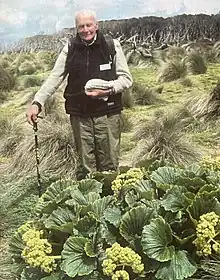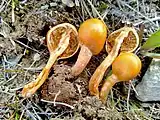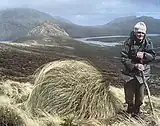Geoff Baylis
Geoffrey Thomas Sandford Baylis (24 November 1913 – 31 December 2003) was a New Zealand botanist and Emeritus Professor specialising in plant pathology and mycorrhiza. He was employed at the University of Otago for 34 years undertaking research into plant and fungal ecology and symbiotic interactions, taxonomy and anatomy. He collected hundreds of plant specimens in the field and founded the Otago Regional Herbarium (OTA). He discovered the sole Pennantia baylisiana living on Three Kings Island in 1945, and was elected as a Fellow of the Royal Society of New Zealand in 1961.
Geoff Baylis | |
|---|---|
 | |
| Born | 24 November 1913 Palmerston North |
| Died | 31 December 2003 |
| Education | Doctor of Philosophy, Master of Science |
| Occupation |
|
| Parent(s) |
|
| Family | Geraldine Chamberlain |
| Awards |
|
| Academic career | |
| Thesis | The influence of certain fungi on the germination of peas; and, A physiological study of the pathogenicity of several species of Sclerotinia, Some observations on Avicennia officinalis Linn in New Zealand |
| Academic advisor | Olga Livia Gertrude Adams, William Brown |
| Doctoral students | Peter Johnson |
| Author abbrev. (botany) | G.T.S.Baylis |
Early life and education
Baylis was born in Palmerston North to Gerald Baylis, an agricultural scientist, and his wife Daisy (Kathleen Daisy Baylis (nee Aston), sister of New Zealand botanist Bernard Aston).[1][2] The family moved to Campbells Bay on Auckland's North Shore in 1920, where Geoff and his sister Geraldine attended Takapuna Primary School and were then some of the first students at Campbells Bay School.[1][3]
Geoff attended Takapuna Grammar School before enrolling at the University of Auckland (then Auckland University College) in 1931.[1] In 1935, he earned his MSc on the ecology of the mangrove Avicennia resinifera (now Avicennia marina subsp. australasia) with a thesis entitled, "Some observations on Avicennia officinalis Linn in New Zealand".[4][5][1] In 1936, a scholarship enabled Baylis to attend London Imperial College where he gained his PhD in 1938 in Plant Pathology.[4][6][1] His PhD thesis was entitled, "The influence of certain fungi on the germination of peas; and, A physiological study of the pathogenicity of several species of Sclerotinia".[6]
On returning to New Zealand, Baylis joined the DSIR at Lincoln where he researched diseases of linen flax (Linum usitatissimum).[1] In 1940, he volunteered for the Royal New Zealand Navy. During his World War II service he served on board HMS Crocus on Atlantic convoy duty.[1][7]
Professional life
In 1946, he was appointed Lecturer-in-Charge of Botany at University of Otago, taking over from the Rev. Dr J. E. Holloway.[4] He became first Professor of Botany (1952) and was Head of the Department for 34 years, retiring in 1978.[4] Based on his numerous plant collections, Baylis founded the Otago Regional Herbarium (OTA), which is located at the Botany Department at the University of Otago.[8][9]
Geoff Baylis' research made several important contributions to our understanding of the role of mycorrhizae, or the symbiotic relationship between plant roots and soil fungi.[1][10] His pioneering experiments on endomycorrhizae in broadleaf (Griselinia littoralis) showed that seedlings growing in natural soils develop vescicular-arbuscular mycorrhizae by associating with fungi that assist with phosphorus uptake, whereas seedlings that did not develop such mycorrhize stagnated.[1][11] Other researchers at the University of Otago (including Baylis and his research students) and elsewhere completed similar studies on other plants thereby extending his early results.[1]
Honours and awards
He was elected a Fellow of the Royal Society of New Zealand in 1961, and attended his last Fellows' AGM on his 90th birthday, as one of the two longest serving living fellows.[1] He served on the Otago Museum Trust Board as the University's Representative.[1] He received the Royal Society's Hutton Medal in 1994; he was a foundation and life-long member and President of the New Zealand Ecological Society; and in 1997 he was elected an Associate of Honour of the Royal Horticultural Institute of New Zealand.[1] He also served for many years on the Catlins Forest Park Advisory Committee.[1] In 1959, Geoff became one of the three founding Governors of the Hellaby Grasslands Trust, a position he maintained for 42 years.[12]
The annual Geoff Baylis Lecture was established by the Botanical Society of Otago in 2002 to honour his contributions to the society and field of botany.[9] Geoff Baylis was the speaker at the inaugural lecture in 2002, and as of 2022 there have been a total of 20 different lectures and speakers in the intervening years.[13]
The standard author abbreviation G.T.S.Baylis is used to indicate this person as the author when citing a botanical name.[14]
Eponymy
The following species of plants and fungi have been named in honour of Geoff Baylis:
- The critically endangered tree, Pennantia baylisiana (W.R.B.Oliv) G.T.S.Baylis, or Three Kings kaikōmako.[15]
- The liverwort Plagiochila baylisii Inoue & R.M.Schust., which was thought to be endemic to Fiordland, South Island, New Zealand[16] but is also known from Tasmania, Australia.[9][17]
- The critically endangered[18] secotioid fungus Deconica baylisiana (E. Horak) J.A. Cooper (originally described by Egon Horak in 1971 as Nivatogastrium baylisianum E. Horak).[19]
Family and personal life
In his younger years, Baylis was an avid mountaineer and took part in several climbing trips to the Southern Alps. In 1965 he and his climbing companions had to be rescued by plane after being trapped by bad weather on the Volta Glacier.[1]
Baylis flatted in, and later bought, the historic Dunedin house "Threave" in upper High Street, a Robert Lawson-designed house which he fully restored, as well as extending the building's woodland surrounds. He became a collector of art and antique silverware and porcelain, and was a regular attendee at classical music concerts.[1] He also had an extensive garden which contained both native and exotic species.[9]
Geoff remained unmarried throughout his life, but kept close ties with his sister Genevieve Chamberlain and her family. He moved back to Campbells Bay, next door to the original family home (which he had bought and restored for his nephew Geoffrey Chamberlain). He died there on New Year's Eve, 2003, at the age of 90.[1]
Taxon names authored
Geoff Balyis named seven species in four different genera of plants.[20]
- Elingamita G.T.S.Baylis[21]
- Elingamita johnsonii G.T.S.Baylis[21]
- Pennantia baylisiana (W.R.B.Oliv) G.T.S.Baylis[15]
- Solanum aviculare var. latifolium G.T.S.Baylis[22]
- Solanum capsiciforme (Domin) G.T.S.Baylis[22]
Selected works
- Geoffrey Thomas Sandford Baylis (1935). "Some observations on Avicennia officinalis Linn in New Zealand". Auckland. Wikidata Q114901240.
- Baylis, Geoffrey Thomas de Sandford (1938), The influence of certain fungi on the germination of peas; and, A physiological study of the pathogenicity of several species of Sclerotinia, London, doi:10.25560/95480, Wikidata Q114900838
{{citation}}: CS1 maint: location missing publisher (link) - G T S Baylis (1940). "Leaf anatomy of the New Zealand mangrove" (PDF). Transactions and Proceedings of the Royal Society of New Zealand. 70: 164–170. ISSN 1176-6166. Wikidata Q89182598.
- G T S Baylis (1954). "Rust fungi on New Zealand Clematis" (PDF). Transactions of the Royal Society of New Zealand. 82: 633–637. ISSN 0035-9181. Wikidata Q89183489.
- Geoffrey Thomas Sandford Baylis (1958). "A Botanical Survey of the Small Islands of the Three Kings Group". Records of the Auckland Institute and Museum. 5: 1–12. ISSN 0067-0464. JSTOR 42906087. Wikidata Q58676758.
- G.T.S. Baylis (December 1959). "Effect of vesicular-arbusuclar mycorrhizas ongrowth of Griselinia littoralis (Cornaceae)". New Phytologist. 58 (3): 274–278. doi:10.1111/J.1469-8137.1959.TB05358.X. ISSN 0028-646X. Wikidata Q113831233.
- G.T.S. Baylis (1961), The significance of mycorrhizas and root nodules in New Zealand vegetation, vol. 89, pp. 45–50, Wikidata Q114902717
- G. T. S. BAYLIS (April 1967). "Experiments on the ecological significance of phycomycetous mycorrhizas". New Phytologist. 66 (2): 231–243. doi:10.1111/J.1469-8137.1967.TB06001.X. ISSN 0028-646X. Wikidata Q56503745.
- G. T. S. BAYLIS (March 1969). "Synthesis of mycorrhizas in Podocarpus and Agathis with endogone wpores". Nature. 221 (5187): 1267–1268. doi:10.1038/2211267B0. ISSN 1476-4687. Wikidata Q58975972.
- G. T. S. BAYLIS (September 1969). "Mycorrhizal nodules and growth of Podocarpus in nitrogen-poor soil". Nature. 223 (5213): 1385–1386. doi:10.1038/2231385A0. ISSN 1476-4687. Wikidata Q59093467.
- G. T. S. Baylis (1970). "Root hairs and phycomycetous mycorrhizas in phosphorus-deficient soil". Plant and Soil. 33 (1–3): 713–716. doi:10.1007/BF01378261. ISSN 0032-079X. Wikidata Q113401845.
- A.F. Mark; G.T.S. Baylis; K.J.M. Dickinson (March 1991). "Monitoring the impacts of deer on vegetation condition of Secretary Island, Fiordland National Park, New Zealand: A clear case for deer control and ecological restoration". Journal of the Royal Society of New Zealand. 21 (1): 43–54. doi:10.1080/03036758.1991.10416109. ISSN 0303-6758. Wikidata Q56974937.
Image Gallery
 Deconica baylisiana growing at Mt Kyeburn in New Zealand
Deconica baylisiana growing at Mt Kyeburn in New Zealand Geoff Baylis with Chionochloa antarctica on Campbell Island, Auckland Islands, November 2000, photo by Alan Mark
Geoff Baylis with Chionochloa antarctica on Campbell Island, Auckland Islands, November 2000, photo by Alan Mark.jpg.webp) Pennantia baylisiana herbarium specimen collected by Geoff Baylis
Pennantia baylisiana herbarium specimen collected by Geoff Baylis
References
- Wardle, Peter; Galloway, David John (1 September 2004). "Geoffrey Thomas Sandford Baylis MSc (N.Z.), PhD (Lond.), DIC, FRSNZ,AHRHINZ (1913–2003)". New Zealand Journal of Botany. 42 (4): 709–714. doi:10.1080/0028825X.2004.9512922.
- Godley, E.J. (June 1996). "Biographical Notes (22): Bernard Cracroft Aston (1871-1951)" (PDF). New Zealand Botanical Society Newsletter. 44: 26–28.
- Campbells Bay School Jubilee Committee (October 2000). "Campbells Bay School 75th Jubilee" (PDF): 6–7.
{{cite journal}}: Cite journal requires|journal=(help) - Baylis, Geoff (2004). Founded on fact : the autobiography of Geoff Baylis. [The author]. OCLC 156472774.
- Baylis, G.T.S. (1935). Some observations on Avicennia officinalis Linn in New Zealand. Auckland: MSc thesis, University of Auckland.
- Baylis, Geoffrey Thomas de Sandford (1938). The influence of certain fungi on the germination of peas ; and, A physiological study of the pathogenicity of several species of Sclerotinia (Ph.D. thesis). University of London. doi:10.25560/95480.
- "Geoffrey Thomas Sandford Baylis". Online Cenotaph. 8 October 2022.
- Botany, Department of. "Facilities". www.otago.ac.nz. Retrieved 29 October 2022.
- Knight, Allison (2002). "BSO Honours Geoff Baylis" (PDF). Botanical Society of Otago Newsletter. 34: 4–6.
- Baylis, Geoffrey Thomas Sandford (1 January 1961). "The significance of mycorrhizas and root nodules in New Zealand vegetation". 89: 45–50.
{{cite journal}}: Cite journal requires|journal=(help) - Baylis, Geoffrey Thomas Sandford (1 December 1959). "Effect of vesicular-arbusuclar mycorrhizas ongrowth of Griselinia littoralis (Cornaceae)". New Phytologist. 58 (3): 274–278. doi:10.1111/J.1469-8137.1959.TB05358.X.
- "Hellaby Grasslands Trust". www.hellabygrasslandstrust.org.nz. Retrieved 17 September 2022.
- "Botanical Society of Otago". bso.org.nz. Retrieved 14 September 2022.
- International Plant Names Index. G.T.S.Baylis.
- Baylis, Geoffrey Thomas Sandford (1 June 1977). "Pennantia baylisiana(Oliver) Baylis comb. nov". New Zealand Journal of Botany. 15 (2): 511–512. doi:10.1080/0028825X.1977.10432558.
- "Plagiochila baylisii". New Zealand Plant Conservation Network. Retrieved 29 October 2022.
- Renner, Matt A. M. (1 January 2018). "A revision of Australian Plagiochila (Lophocoleinae: Jungermanniopsida)". Telopea. 21: 187–380. doi:10.7751/TELOPEA12959.
- IUCN (23 July 2019). "Deconica baylisiana: Cooper, J.A.: The IUCN Red List of Threatened Species 2019: e.T154239294A154239311". doi:10.2305/iucn.uk.2019-3.rlts.t154239294a154239311.en.
{{cite journal}}: Cite journal requires|journal=(help) - Horak, E. (1 September 1971). "Contributions to the knowledge of the Agaricales s.l. (Fungi) of New Zealand". New Zealand Journal of Botany. 9 (3): 463–493. doi:10.1080/0028825X.1971.10430194. ISSN 0028-825X.
- "International Plant Names Index". ipni.org. Retrieved 28 October 2022.
- Baylis, Geoffrey Thomas Sandford (1 January 1951). "Elingamita (Myrsinaceae) a New Monotypic Genus from West Island, Three Kings". Records of the Auckland Institute and Museum. 4: 99–102.
- Baylis, Geoffrey Thomas Sandford (1 January 1963). "A cytogenetical study of the Solanum aviculare species complex". Australian Journal of Botany. 11 (2): 168. doi:10.1071/BT9630168.